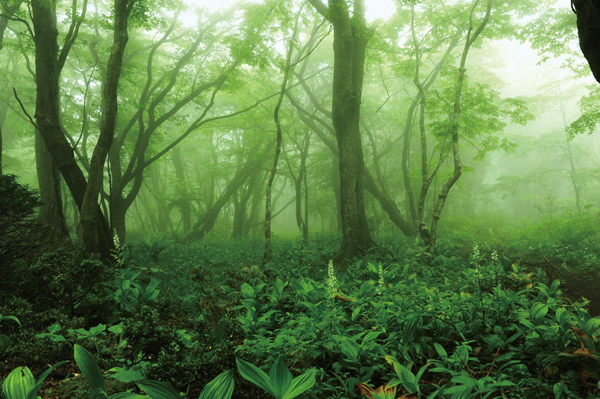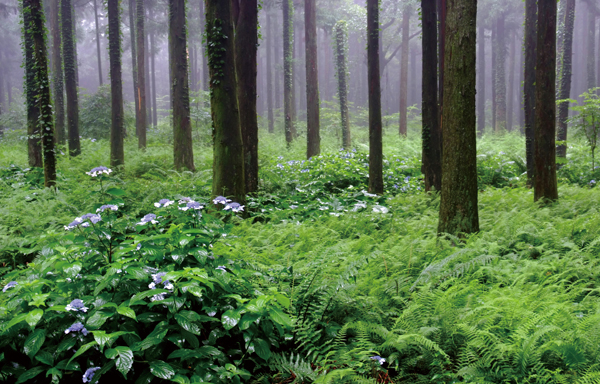| |
 |
|
| ▲ Photo courtesy Jeju Tourism Organization |
Click here for a guide to Jeju's woodland walks from Jeju Travel.
Everyone knows the benefits of a walk in the woods. Personally, I rarely feel better than after a lung-bursting, pore-opening run through the trees, all the better if ferns and undergrowth scratch my mud-caked calves.
I am on a high for the rest of the day, feeling exhilarated and energized. I look back on my morning accomplishment, confident that my first few hours awake could not have been better spent.
It is not just at this subjective level that “forest baths” are great for us, science is increasingly showing that trees, forests and green spaces are not only essential components of healthy ecosystems but also, as if it needs saying, human health.
Trees not only turn carbon dioxide into oxygen through photosynthesis, but also filter and remove airborne pollutants such as carbon monoxide, lead, nitrogen dioxide, ozone, sulphur dioxide and particulates from our urban areas.
They also pump out beneficial aerobic particles such as phytoncide, “a biologically active substance of plant origin that kills or inhibits the growth and development of bacteria, microscopic fungi, and [microorganisms].” It is crucial to plant immunity and ecosystem health by stemming the growth of damaging organisms.
While repellant to such organisms, human exposure to phytoncides is said to boost immunity for over a week, and help combat allergies, asthma and skin problems. They also repel 97.2 percent of dust mites and fungi, eliminate odors and stimulate the central nervous system to relieve tension and stress.
Japanese research suggests extended periods of time among trees can lead to “lower concentrations of cortisol, lower pulse rate, and lower blood pressure.” Levels of white blood cells, which help fight infections by attacking bacteria, viruses, and germs, are raised after woodland walks. Natural Killer Cells in particular, crucial even in attacking cancers, can be boosted by as much as 50 percent.
Accordingly, woodland cover has been directly linked to “significant decline in stress, improved rehabilitation, faster hospital recovery rates, and a decrease in the severity of symptoms in attention deficit disorders.”
| |
 |
|
| ▲ Photo courtesy Jeju Tourism Organization |
The threat to our green spaces
This should make us happy, living on an island with 49 percent forest cover when experts recommend a minimum of 30 percent to maintain a healthy, sustainable ecosystem. However, despite the 1,257 square kilometers of protected land in the province, there are still plenty of threats to our green spaces.
Much of the 200,000-square-meter Energy Town in Dongbok-ri, Gujwa-eup, is being built on Jeju’s scarce Gotjawal habitat. Ironically the project, lauded as essential to Jeju’s World Environmental Capital bid, will include a “Healing Town.”
The vast 4-million-square-meter Myths and History Theme Park, in Andeok-myeon, Seogwipo City, will fence off, privatize and concrete a vast area of woodland, pastures and farmland, likely including many sites of value to Jeju’s actual myths and heritage.
Even Jeju Healthcare Town sits on 1.5 million square meters of once woodland and greenery, bordered by a planned 2.4 million square meter tourism complex, 75 percent of which is Seogwipo forest. The Gotjawal remaining at Jeju Global Education City awaits new schools, and the bulldozers. These projects are all but finalized, and more will come in the years ahead.
Forests in many ways serve as our natural health insurance and a sustainable preventative health measure for communities. Who knows what the cost of losing the Gotjawal habitat - known as “the lungs of Jeju” - will be for local health, and thus the public purse?
Woodlands are also our flood defences and soil nutrient givers, and they protect against landslides and erosion. Beyond short-term economic gains, they should be seen for their long-term ecological and societal worth, particularly in an era of increasingly extreme weather conditions.
This is, admittedly, an anthropocentric view of nature, but why not be more aware of the economic and health costs of not protecting Jeju’s environment? Perhaps by taking such a view the provincial coffers could be lined just as abundantly, yet sustainably.
So, as the 3Ds of drought, disease and development chip away at our remaining tree cover, get out there and get under it. And while you are there look not to the heavens but to the canopy, and say a few words of thanks.
Click here for a guide to Jeju's woodland walks from Jeju Travel. |





















